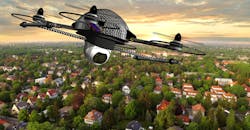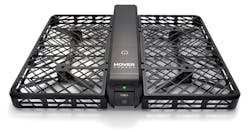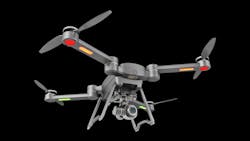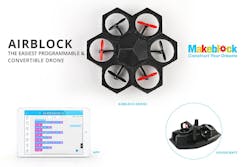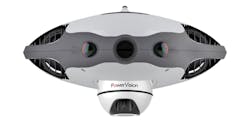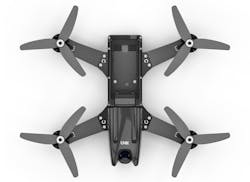Download the PDF of this article.
Drones—those UAVs that can be found flying almost everywhere today—have come a long way in the last decade, evolving from simple hobby into technological marvel in every way. Companies are consistently introducing new machines with advanced capabilities that cover a wide range of applications, from putting on incredibly choreographed displays to delivering pizza and everything else imagination can conceive.
2017 is just beginning, and we already see new drones from a myriad of big-name companies and startups, including Zero Zero Robotics, GDU, Autel, Simtoo, and many more. Some feature modular systems for 4K image resolution, gesture control, and interchangeable parts for different applications. In this roundup, we will take a look at some of the more interesting designs and adaptations that have already hit the market, or releasing this year, that go beyond simple aerial coverage.
Courtesy: Hover Camera
Hover Camera Passport, $599
It’s compact, foldable, and features face and body tracking. Hover Camera’s Passport is great for those who want a hands-free selfie platform capable of 4K video. The carbon-fiber quadcopter design features a pair of foldable fan housings for compact storage and packs a 13-megapixel camera for grabbing 4K video at 30 FPS.
Simply power up the drone in your hand and let it go. The Passport will keep its eye on you through facial recognition and body tracking, allowing you to get that perfect image or video. Controlling the Passport is done using a mobile app where shots can be taken manually or time programmed. However, a new firmware update will allow you to use hand gestures to take photos and video. The only drawback is that it only has a flight time of 10 minutes before needing a recharge, so make those shots count.
Tracking drones will usher in a new age of filmmaking. Smaller crews making guerilla-style movies are sure to flood our media channels.
Courtesy: GDU
GDU Byrd Premium 2.0, $999
What separates GDU’s Byrd Premium 2.0 from most other personal/professional drones is its ability to be outfitted with the camera and stabilizer of your choice, rather than being stuck with stock. This quadcopter design is also compact with foldable propeller arms, making it about the size of a netbook for easy storage.
What makes this drone unique is that GDU outfitted it with its Universal Flying platform, a modular gimbal platform that can be outfitted with any number of camera and stabilizer systems for any number of applications, such as search and rescue and hazardous industrial inspection. What’s more, you can attach GDU’s Delivery Box next to the camera platform to transport and deliver goods anywhere they may be needed.
As far as specs go, the Byrd Premium 2.0 comes packed with a 6,700 mAh battery for 29 minutes of flight time and a max speed of 15 M/S. It can also carry a payload of up to 2 kg. Controlling the drone is done using a mobile app or dual controller that lets you aim the camera, as well.
Wondering about the flight range like I am? Best-case scenario: 26,100 meters, or 16.2 miles. Then it come crashing down. That is simply amazing; it could film a panoramic scene of my entire city of Chicago!
Courtesy: Wingsland
Wingsland S6, $420
The Wingsland S6 is one of the more compact selfie drones—about the size of a smartphone. It’s also one that comes with the option of “packing heat” and other accessories for the more narcissistic users. The drone features fold-in propeller-equipped winglets, making it one of the smallest pocket drones on the market. It measures out at 138 mm × 79 mm × 26.8 mm.
The Wingsland S6 comes packed with a 4K camera with EIS, GPS/GLONASS dual-satellite navigation (outdoor) and IR/Optical Flow sensors (indoor), along with a 1,400mAh battery for 10 minutes of flight. But what 10 minutes they are, when you can attach accessories such as Wingland’s Boom Boom toy gun, Searchligh,t and Emoji Display for a host of fun applications.
Fun add-ons aside, the S6 can be controlled using an app that can be customized with a virtual joystick, gravity sensor/tilt control, and voice, making it one of the more versatile of the compact platforms.
Courtesy: Makeblock
Makeblock Airblock, $221
Build it, code it, fly it…That’s the idea behind Makeblock’s Airblock drone, designed to be an educational tool for kids looking to tackle the STEM fields. The drone is modular with the CPU, motors, and rotors all encased by hexagonal soft foam that magnetically connects to one another. This makes it easy to put back together if it falls from the air or hits a wall, try doing that with a Parrot. What’s more, the pieces can also be reconfigured to create other vehicles, including a hovercraft and spider crawler.
The idea behind the Airblock is to introduce kids to the maker revolution with the ability to build their own “starter drone” and program it using the Makeblock app, which uses a drag-and-drop platform to input code for seamless movement (even performing aerial routines and other stunts). As an added extra bonus, the Airblock isn’t regulated by the FAA!
I see such a huge push toward coding in toys and early education. I do hope that translates into general technical aptitude—if anything, just so we can play with all the new STEM toys as they come along!
Courtesy: YI Technology
YI Technology’s YI Erida, pricing speculated at $749 to $999
It’s certainly one of the fastest 4K shooters on the planet. YI Technology’s YI Erida can reach up to 75 mph and stay in the air for 40 minutes before needing a recharge. That’s nearing racing drone speeds, when you consider that some of those racing machines can cruise along at well over 100 mph. Not bad considering the drone’s purpose is to take stunning 4K video and HD images.
That’s a 50-mile range! Now that is useful.
The YI Erida is able to reach those speeds and stay in the air longer due to its carbon-fiber skeleton, which makes it both light and strong. It employs an adjustable-angle three-rotor design to give extreme maneuverability. The company strapped their top of the line YI 4K Action Camera to the drone, which is attached to a three-axis gimbal to provide increased stability for image capturing during flight. What’s more, the arms fold back when not in use for compact portability, and it can be controlled using either the YI Erida app or a joystick-style controller.
Courtesy: PowerVision
PowerVision PowerRay, pricing to be announced
Not all drones fly in the air. Some, like PowerVision’s PowerRay, take to the water—or rather, under it, allowing you to explore the sea. Designed for fishing hobbyists, the PowerRay is capable of submerging up to 30 meters and staying there for up to four hours. It features a 4K UHD camera that provides clear images of life below the sea. Can’t see any life? Not a problem: It comes equipped with a detachable SONAR module that can detect fish with positional information up to 40 meters below it.
If the SONAR module doesn’t detect fish, you can switch on the PowerRay blue luring light and engage the remote bait drop to reel them in. For total immersion, connect PowerVision’s VR Goggles, which responds to head tilting, moving the drone camera in the direction you’re viewing. Otherwise, you’re stuck viewing and controlling the PowerRay using a mobile device with accompanying app.
This seems so unfair to the fishies. I think they need to upgrade to keep pace!
Courtesy: UVify
UVify HD Draco, $499
Speaking of racing drones, UVify’s HD Draco is plenty fast, reaching speeds of up to 100 mph. It features an HD wide-angle camera that gives pilots a wider field of view to navigate through narrow tracks and turns. Although most racers prefer to build their own drone, the HD Draco is perfect for those just getting into the sport, and features a modular design that helps with fast battery replacements and rotor swap-outs.
The drone comes equipped with GPS, giving beginners an assisted flight mode and tracking capabilities if problems arise. The modular design is what makes this drone stand out, as each component is compartmentalized: Flight control, IMU, display, camera, speed controller and rotor arms are all separate components that can be swapped out when damaged. The whole arm assembly can be changed out for $30. While it’s not dirt-cheap, it’s still a better option than non-modular designs.
Credit: Propel
Propel Star Wars Battle Drones, $199
Fans of “Star Wars” will certainly channel the Force with Propel’s “Star Wars” Battle Drones, which include a 74-Z Speeder Bike, T-65 X-Wing Fighter, and Tie Advanced X1. The toy drones feature two modes: beginner, which provides a fixed, stable altitude for users to focus on steering; and advanced, which provides total control for stunts and flips. A built-in barometer (the Force) allows the drones to attain stable flight and hover while in the beginner mode.
The drones have a top speed of 35 mph, a range of 200 ft., and built-in eye-safe lasers for battles. They are piloted using a dual-joystick controller that emits sounds when in flight and battle. Players fire the laser at their opponents, with a single hit making their ship wobble and three hits resulting in a crash. What’s more, each drone comes in a handcrafted box that lights up and plays different theme music when opened.
Instead of a crash, how about a gentle forced landing, Propel?
(Courtesy: Twitter—Yuneec Aviation)
Yuneec Valet concept drone, price unknown
Yuneec has a slew of high-quality image-capturing drones that are used by professional outdoorsman to capture the incredible scenery. They even offer an E-longboard (E-GO 2) for what I’m guessing is the downtime for when those drones undergo maintenance. But, what they came out with at this year’s CES is even more intriguing: the Valet, a drone of the future.
The future, indeed. Touted as the “Home Security Drone,” the Valet will patrol your home and property and look for anything out of place before returning to its dock. If it does happen to encounter anything out of the ordinary, it will alert you via phone, allowing you to activate whatever in-house countermeasures you have equipped. It will also apparently allow for virtual tours, letting you see what it sees happening.
Bear in mind that this is just a concept endeavor by Yuneec and may never see the light of day for the consumer market. Then again, maybe it will.
Courtesy: PowerVision
PowerVision PowerEgg, $1,288
The last entry in this roundup comes, once again, from PowerVision with its futuristic-looking PowerEgg. According to PowerVision, the company wanted a friendly-looking approachable drone that anyone can use, hence the egg shape. The quadcopters arms fold into the body when not in use and extend for flight at the push of a button.
PowerVision equipped the drone with the same 4K UHD camera found on the PowerRay, giving you high-resolution images and video with 360-deg. positioning on the undercarriage gimbal. What makes this drone unique is the number of ways you can control it, which includes using gestures or a dual-joystick controller with smartphone docking port to view everything the camera sees.
Beyond those control options, you can also set it to fly to waypoints encompassing a 3.1-mile radius and set it off on autonomous flight. You can also set it to orbit mode, where it follows and rotates around you taking panoramic images and video. With a 23-minute flight time, that makes for some great video. You can also use it indoors thanks to its onboard optical sensors for collision avoidance.
Conclusion
“Drone” became a sort-of buzzword a few years ago, held on the mantel of the future. Everyone wanted on that money train. Many tried, and many dropped out for the next new “hot thing” (VR, or whatever). Those who remained have given us a true glimpse of that promised future. But, we are not there yet.
Let’s state the dream drone requirements: Autonomous following is key. Flight control automation, high speed, long flight times, and way-points are cool. One thing few are addressing: quiet operation! Ever hear one of those larger drones? They sound like all of the angry bees you can imagine together.
About the Author
Cabe Atwell
Engineer, Machinist, Maker, Writer. A graduate Electrical Engineer actively plying his expertise in the industry and at his company, Gunhead. When not designing/building, he creates a steady torrent of projects and content in the media world. Many of his projects and articles are online at element14 & SolidSmack, industry-focused work at EETimes & EDN, and offbeat articles at Make Magazine. Currently, you can find him hosting webinars and contributing to Penton’s Electronic Design and Machine Design.
